
The quality of melting is the guarantee of the quality of glass products. For different glass products, the requirements for the quality of glass melting and homogenization vary slightly. For glass products that demand high quality and grade (such as high-end vessels and specialty glass), the requirements for the uniformity and purity of the glass liquid (control of bubbles and impurities) are extremely strict, and some even exceed those of optical glass. Generally, the production scale of daily-use glassware production lines is smaller than that of flat glass furnaces, and most of them are produced in end fired furnaces. The end fired furnace faces challenges in terms of hot spot stability, bubble boundary control, furnace pressure, and liquid level fluctuation management due to its structural characteristics (the flame is in a U-shaped path).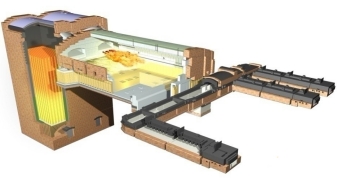
In addition to the optimization of the process system, the selection and application of refractory materials for the lining of the furnace is one of the core elements determining the melting quality and the service life of the furnace. Among them, fused cast AZS blocks, with their excellent resistance to glass liquid erosion, high-temperature structural stability, low pollution and good thermal conductivity, have become the preferred material for modern end fired furnaces, especially for key parts of the melting end (such as sidewalls, throats, corners of the doghouse, and hot spots). Its performance directly affects the service life of the furnace, the melting efficiency, the energy consumption level, and the final quality of the glass liquid. Therefore, for the control of product quality, while adopting the same process management methods as most glass enterprises, it is essential to attach great importance to the selection, application, and maintenance of key refractory materials such as fused cast AZS blocks. This is crucial for achieving high-quality melting in end fired furnaces.
1. Improve the quality of compound material preparation
There are four major stabilities in glass production, namely raw material stability, fuel stability, melting stability, and forming stability, among which raw material stability is the first stability. The glass furnace is a molten liquid mixer, and the mixing equipment is a solid mixer. It can be said that the quality of the compound materials and the quality of glass melting each account for half of the influence on the product quality. Improving the quality of compounding materials is a prerequisite for enhancing the quality of glass melting. To ensure the stability of compounding material quality, the following tasks need to be accomplished:
(1) We must strictly control the quality of raw materials entering the factory, strengthen the management of raw material storage and usage, and ensure that raw materials that do not meet the standards cannot be used in the production of ingredients.
(2) The batching system should operate stably. The operation indicators of weighing, mixing, and conveying equipment should meet the performance requirements. Strengthen equipment maintenance and regular inspections to prevent any abnormalities in the batching system during operation. Strictly control the static and dynamic accuracy of weighing in the batching system. The production processes of weighing, mixing, and conveying should meet the technical requirements of the process. Formulating a reasonable sequence of raw material mixing and strictly testing and assessing the uniformity of compound materials are important steps to improve the quality of compound materials.
(3) Optimize the formula. The compound materials made according to the formula should not only take into account the cost but also the melting situation, that is, the total time it takes for the compound materials to melt into the glass liquid. A formula with a short melting and clarification time can lower the melting temperature and increase the melting rate. Without affecting the performance of glass products, it is necessary to appropriately adjust the composition of the glass, further optimize the formula, increase the melting rate, and improve the quality of glass melting.
(4) Strictly control the particle size distribution of raw materials. The particle size of raw materials is mainly controlled by aluminum-silica raw materials. The formation of silicates only accounts for 9% to 13% of the total melting time of glass, while the melting time of refractory quartz particles accounts for 87% to 91% of the total melting time of glass. Siliceous raw materials with overly coarse particle size are difficult to melt, but those with overly fine particle size tend to form lumps, which are hard to stir evenly during mixing. Moreover, when overly fine raw material particles melt, they will produce microbubbles, making clarification difficult and prolonging the clarification time. In severe cases, the "starry sky" bubble defect may occur in glass products.
(5) Appropriately increase the proportion of broken glass. Adding a certain proportion of crushed glass as a flux during the melting process of glass can accelerate the melting of the compound and increase the melting rate of the glass. The ideal proportion of broken glass is about 30%. However, the amount of broken glass produced during the production process in glass factories is relatively low, often not exceeding 10% of the total input. It is necessary to purchase cheap waste glass products, which can reduce raw material costs. However, it is necessary to ensure that the quality of the purchased broken glass meets the standard requirements and that the melting quality of the glass is guaranteed.
(6) Use the physical and chemical property indicators of glass for production control. In glass production, the stability of glass composition is an important prerequisite for improving the quality of glass products. At present, the batching accuracy of raw materials, weighing, mixing, and conveying in the compound material preparation process is not ideal, and most of them are in an unstable state. The control of the fluctuation of glass composition is also not ideal. It is difficult to control the production process in a timely and effective manner by relying solely on the traditional volumetric analysis method to test the glass composition. It is very necessary to control the glass production with the measurement data of the physical properties of glass. Advanced countries generally control glass production by testing physical property indicators such as the linear expansion coefficient, density, and softening point of glass. By using glass system engineer software to calculate and analyze these physical property indicators, the composition of glass samples can be analyzed quickly and accurately, and compared with the formula promptly. Targeted adjustment measures can be taken to stabilize and improve the quality of glass production.
2. High-performance fused cast AZS blocks are applied to ensure a stable melting environment
The melting process of the compound materials in the furnace is always in an environment of direct contact and intense reaction with the lining of refractory materials (especially the sidewalls, bottoms, and throat of the melting end). The selection of high-quality fused cast AZS blocks (such as AZS33#, 41#) is a key foundation for ensuring a stable melting environment. Fused cast AZS blocks have the following significant advantages:
Outstanding resistance to erosion: Its dense and uniform structure can effectively resist the chemical erosion and physical scouring of high-temperature glass liquid, significantly reducing the risk of refractory material dissolved substances entering the glass liquid to form stones, ensuring the purity of the glass liquid.
Excellent high-temperature structural stability: It can maintain high strength at temperatures above 1500℃, with good creep resistance and thermal shock resistance. It can withstand temperature fluctuations caused by operations such as fire changing and commissioning in end fired furnaces, and maintain the geometric shape stability of key parts of the furnace. This is crucial for stabilizing the hot spot position and optimizing the glass liquid flow field.
Extremely low pollution tendency: The glass phase content in fused cast AZS blocks is low and evenly distributed, with little seepage at high temperatures. The risk of streaks caused by the glass liquid is much lower than that of bonded refractory materials.
Good thermal conductivity: It is conducive to the effective transfer and distribution of heat and has a positive effect on stabilizing the melting temperature system.
Therefore, while pursuing high quality in the preparation of compound materials, it must be recognized that only by relying on the stable, clean, and durable "reaction vessel" constructed with high-performance fused cast AZS blocks in the key parts of the melting end can high-quality compound materials be efficiently melted into high-quality glass liquid. The quality of fused cast AZS blocks, masonry accuracy, and later maintenance (such as "binding bricks" or "hot patching" on the sidewalls in hot spots) are the material guarantees for the stable and controllable melting process of the compounding materials.
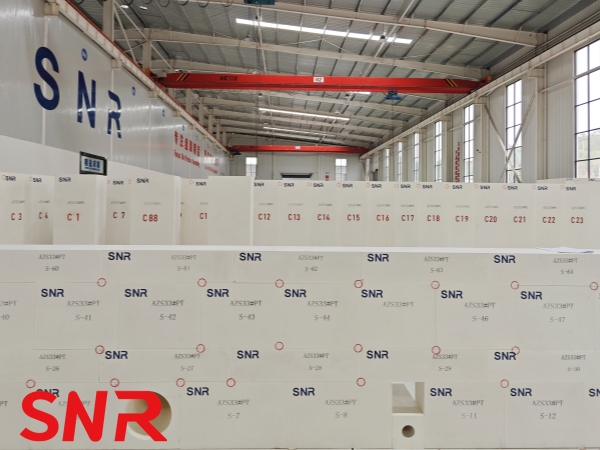
3. Requirements for flame control of end fired furnaces
The melting operation plays a crucial role in ensuring the stable working conditions of the furnace and improving the melting quality. The operator should regularly check the changes in the length, height, stiffness, and brightness of the furnace flame. The combustion state of the flame directly affects the location of the hot spot and the temperature distribution, which is crucial for the service life of the furnace lining, especially for the fused cast AZS blocks in high-temperature and high-erosion areas. The temperature is the highest within the range of 1.2 to 1.8 meters at the end of the melting furnace flame (hot spot). The end should be as close as possible to the material pile, controlled within the majority of the feeding and melting area, within 2/3 of the hot spot position, and the bubble boundary within 1/2 to 2/3 of the range. If the hot spot position is well controlled, it can accelerate the flow and circulation of the glass liquid, the bubble boundary position is obvious, the heat utilization rate of flame combustion is high, and the effect of energy conservation and consumption reduction is obvious. A stable hot spot position can prevent the long-term fixed erosion of a certain point of the furnace by high-temperature flames, protect the refractory materials in the chest wall, port arch and other parts (usually silica bricks or fused cast AZS blocks in specific areas), and also help to reduce the local severe erosion of the sidewall in the hot spot area by high-temperature glass liquid. As long as the positions of the flame hotspots and bubble boundaries meet the process requirements and the hot spot range is relatively long, the goal of good glass melting quality and high product quality can be achieved.
The optimized flame control not only enhances the thermal efficiency but also reduces the thermal stress impact on the fused cast AZS blocks masonry caused by drastic temperature fluctuations, which is conducive to prolonging its service life. A smooth flame reversal is particularly important for protecting the large arch silica bricks and the fused cast AZS blocks at the arch slag sections.
4. Glass melting system
4.1 Observation and control of the melting part temperature
Install a radiation pyrometer in the observation hole on the opposite side wall of the feeding port to observe the combustion state of the flame and the melting effect of the material pile. Radiation pyrometers are installed at the middle and rear observation holes on both sides of the melting section to observe the clarification and homogenization process of the glass liquid. Thermocouple temperature measurement devices are installed at the top positions of 1/2 and 2/3 in the middle of the furnace, which are used as the measurement points for the temperature of the entire furnace. Observe the shape of the furnace flame, the brightness of the furnace wall bricks and top bricks, the position of the bubble boundary line, etc., from the corresponding observation holes. The position of the bubble boundary line generally should not exceed two-thirds of the total length of the melting furnace. At regular intervals, manual detection is carried out through the observation hole with a handheld radiation thermometer to comprehensively analyze the melting temperature conditions.
In the production of daily glass, operations such as production change, replacement of refractory materials of the feeder, or shutdown of the forming machine due to failure will cause changes in the temperature system of the melting furnace. Such changes may cause hot spots, bubble boundary deviation and flow channel temperature fluctuation, resulting in unstable forming and product quality defects; in serious cases, it may change the flow state of glass liquid, causing the thickness of the "immovable layer" at the bottom of the pool to change, and the glass liquid inside it will mix into the forming flow, aggravating the unevenness and causing cracking and other problems. At this time, it is necessary to adjust the temperature system to stabilize the melting hot spot temperature and bubble boundary position.
Fused cast AZS blocks (such as AZS41#) located in the high-temperature zone of the melting pool have extremely high refractoriness and creep resistance, which is a reliable guarantee for maintaining the stability of the hot spot temperature and withstanding the long-term scouring and chemical erosion of high-temperature glass liquid. Its excellent thermal shock stability also helps to cope with temperature fluctuations caused by production or malfunctions.
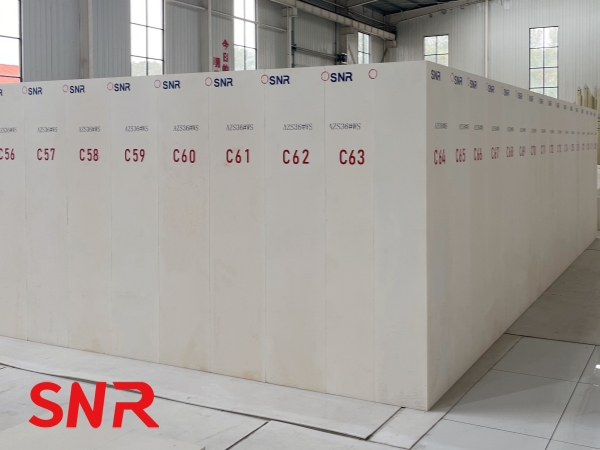
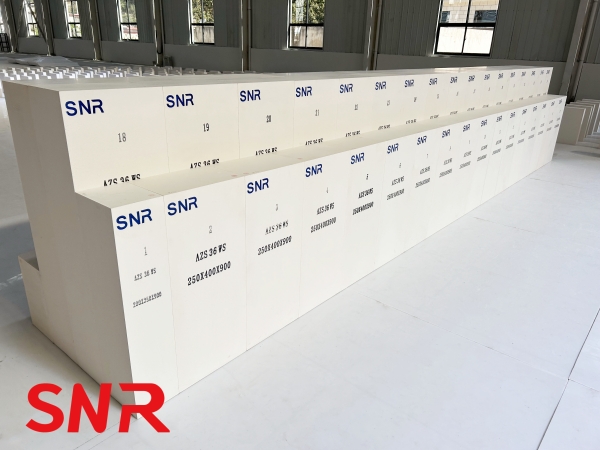
4.2 Melting temperature system
The melting temperature is an important operational index for glass melting. Temperature fluctuations have a significant impact on the stability of the melting hotspots and bubble boundaries. As the horseshoe flame alternates between two sets of fires, the temperature curve along the longitudinal axis is prone to fluctuations, making control rather difficult. Therefore, frequent observation and adjustment are necessary. Through the reversing operation of the regenerative chamber, it is observed that the adjusted state should be stable and consistent. In terms of the process system, a reasonable temperature system should be established along the length of the furnace. For the end fired furnace, the most important factors for the melting temperature are the hot spot temperature and position. Only when the hot spot temperature is prominent inside the furnace and the temperature value and position meet the specified requirements can an ideal bubble boundary be easily formed inside the furnace. The temperature value of the hot spot depends on the type of glass being melted, the fuel, and the quality of the refractory materials used in the furnace. By adjusting the combustion air volume and gas ratio of the port, the flame length, brightness and stiffness required by the process are achieved, so that the combustion flame of the port reaches the ideal state, the hot spot temperature is prominent, and the temperature curve along the horizontal direction conforms to the process requirements. Strengthen the monitoring, analysis, and control of flue gas components, adjust the flow of combustion-supporting air and fuel promptly to achieve a scientific wind-fire ratio, and improve the heat transfer efficiency of combustion. The process of melting multiple solid-phase compound materials through an appropriate temperature curve to transform them into a single and uniform glass phase, and eliminating visible bubbles through clarification. There are five stages in the melting of glass, namely the silicate formation stage, the glass formation stage, and the clarification stage. The temperature is 1400-1500℃, the homogenization stage, and the cooling and forming stage. The material pile, bubble boundary line, clarification zone, and mirror surface zone meet the process requirements. Finally, high-quality glass liquid is melted out and formed through the throat.
In the automatic control system of glass furnaces, the temperature control of automatic fuel regulation is a relatively reliable control method. In daily operations, the stability of the melting temperature is achieved by relying on automatic temperature control. The automatic temperature control system automatically regulates the flow of fuel and combustion-supporting air to keep the temperature measured by the thermocouple at the top of the furnace stable. Three thermocouples are generally installed on the top of the furnace to measure the temperature. The signals from the three thermocouples can be added in a certain proportion to serve as the automatic control temperature value. The proportion value can be adjusted according to the actual situation. If one of the thermocouples malfunctions, the overall temperature of the furnace can be effectively controlled through proportion adjustment.
The high-quality fused cast AZS blocks used on the top and key parts of the furnace, especially the fused cast AZS blocks used on the walls and bottom of the melting end, provide a solid material basis for precise temperature control and withstanding high-temperature loads. The low porosity and high density of fused cast AZS blocks also reduce the probability of glass liquid contamination caused by the refractory materials themselves.
4.3 Control of bubble boundaries in horseshoe flame furnaces
During the melting process of glass, the bubble boundary line is used to reflect the melting quality and clarification quality of the glass. The end fired furnace for producing ordinary glass products has no clear requirements for the bubble boundary line, while the glass products with high quality requirements have stricter requirements for the bubble boundary line. Due to the long flame travel of the end fired furnace, the flame combustion path is on both sides of the longitudinal axis of the furnace, forming a U shape, and the cross-section of the hot spot presents an arc shape. The ideal melting state of the end fired furnace is that there are no scum or bubbles in the area at one end of the throat and the two right-angle zones, presenting a mirror-like state. The boundary between this mirror and the scum is the bubble boundary of the end fired furnace. The larger the area of the mirror surface, the more ideal the bubble boundary, and the better the clarity quality of the glass liquid. In the remaining foamy scum area, its state varies with the change of heat and the amount of feed. The control of the bubble boundary line in the end fired furnace should adopt process and technical measures to improve the melting operation, enhance quality awareness, and strive to improve the bubble boundary line condition of the furnace.
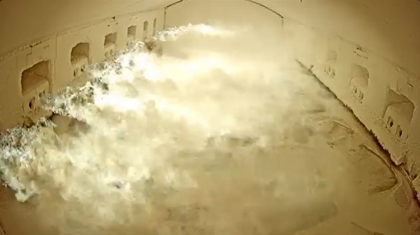
(1) Evenly feed in thin layers. If there is concentrated feeding and the material layer is relatively thick, causing the unmelted material pile to cross the clarification zone, the forming flow will carry the unmelted and unclarified glass liquid through the throat, resulting in inclusions and other defects in the glass products and causing quality problems. Thin-layer feeding is an effective means to accelerate the melting rate of compound materials and improve the bubble boundary. The thickness of the material layer is one of the important process control parameters of the end fired furnace. Its thickness should vary according to the type of glass, and the thickness of the vessel glass is generally controlled between 90 and 150mm. The doghouse area and sidewalls built with high-quality fused cast AZS blocks, due to their extremely smooth surface and strong resistance to erosion by the material pile, are conducive to the rapid spreading and melting of the compound materials, reducing the risk of unmelted materials being swept up at the "bottom of the material pile", and have a positive effect on the formation and maintenance of clear and stable bubble boundaries.
(2) Adjust the flame size promptly according to the changes in the discharge volume. If the discharge volume changes but the flame size is not adjusted in time, and the heat input during the melting process remains unchanged, both the melting hot spot and the bubble boundary will undergo relatively significant changes. Therefore, under normal production conditions, the range of the hot spot area should be adjusted promptly according to the changes in the output volume, and the heat input by the flame to the melting end should be adjusted accordingly.
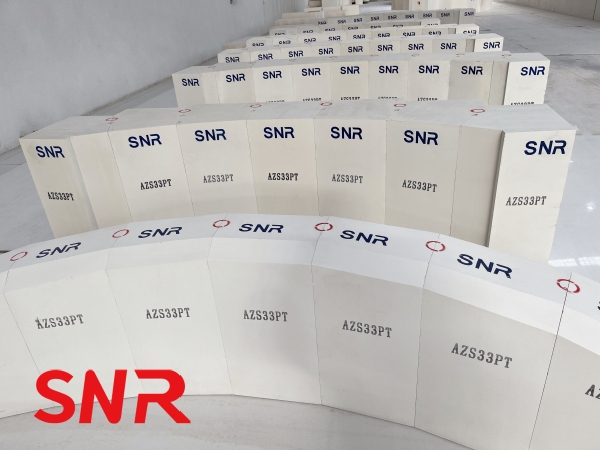
(3) When the formula is adjusted or the quality of the compound material changes, the flame size should be adjusted in time to avoid affecting the position of the hot spot and the bubble boundary. The formula adjustment is made based on a series of physical and chemical performance requirements of glass products. After formula adjustment, the melting capacity of the compound material and the thickness of the material layer will change to a certain extent. The changes in the composition, particle size, moisture content of glass raw materials, and the uniformity of compounding materials will affect the changes in the thickness of the material layer. It is necessary to carefully observe the position changes of the bubble boundary line and make timely adjustments to the temperature curve according to the changes. Changes in the formula or compounding materials may lead to alterations in the melting temperature or the properties of the glass liquid, which pose adaptability requirements for refractory materials, especially fused cast AZS blocks that come into direct contact with the glass liquid. High-quality fused cast AZS blocks have a broader range of chemical stability and corrosion resistance, which can better adapt to such changes, reduce the risk of increased inhomogeneity of the glass liquid due to intensified erosion of refractory materials (such as the formation of streaks or stones), and indirectly affect the quality of the bubble boundary and the clarification and homogenization effect of the glass liquid.
4.4 Control of furnace pressure
Furnace pressure is one of the very important parameters in the process operation of glass furnaces. Regardless of the size of the furnace, it is required that each point inside the furnace maintain a slight positive pressure. This plays a significant role in the safe operation of the furnace, the stability of the melting conditions, and ensuring the high-quality production of glass liquid. Excessive furnace pressure is not only detrimental to the stability of melting, affecting the clarification of the glass.jpg) liquid, but also causes the flue gas to be ejected from the melting furnace, resulting in a decrease in furnace temperature, an increase in flue temperature, an increase in energy consumption, and an intensification of the erosion of refractory materials. At the same time, it slows down the process of fuel mixing and combustion, reduces the melting capacity, and leads to a decline in the quality of the glass liquid melting. When the furnace pressure is too low and negative pressure occurs at the glass liquid level inside the furnace, due to the intake of cold air, it interferes with the normal combustion of the flame, causing fluctuations in the temperature curve. This will lower the melting temperature of the glass, increase heat loss, make melting difficult, reduce the melting effect and efficiency, increase energy consumption, and is also not conducive to the clarification of the glass. The bubbles produced are difficult to discharge, and the product quality will decline. The operator was observing the doghouse. A small amount of exhaust gas was emerging outward, and the flow rate was slow, which was considered appropriate. You can also observe the length of the flame in the observation hole in the middle of the furnace chest wall. The length of the flame's emission should be controlled within an appropriate range. The control of furnace pressure should ensure a slight positive pressure inside the furnace, which is conducive to the pushing of the material pile and the balance of the liquid flow inside the furnace. The general requirement for furnace pressure control is a slightly positive pressure (2 to 4Pa) near the glass liquid, and a furnace pressure of 12 to 20Pa at the large arch of the melting furnace. The factors influencing the stability of furnace pressure include environmental climate temperature, atmospheric pressure, resistance of the furnace's regenerative chamber, flue temperature, opening degree of the flue gate, fuel flow rate, and combustion-supporting air flow rate, etc. The furnace pressure should be maintained in the optimal state at all parts in accordance with the requirements of the operating procedures. Any fluctuations should be adjusted promptly. Furnace pressure stability is controlled by adjusting the fuel flow rate, combustion-supporting air flow rate, and the opening degree of the flue gate plate under the premise of ensuring the stability of the temperature at the melting hot spot. In the automatic control system of the furnace, furnace pressure display and control instruments are adopted to achieve automatic control and stabilize the furnace pressure. In daily operation, the main issue with furnace pressure control is an abnormal increase in furnace pressure. When furnace pressure rises, the first things to consider and check are water accumulation in the flue, ash accumulation in the flue, and blockage of the grate in the regenerator, etc. If these problems exist, they should be analyzed carefully, and feasible measures should be taken to solve them. Regular manual cleaning should be carried out on the flue and regenerator to keep the airflow unobstructed and ensure the normal operation of the furnace melting operation.
liquid, but also causes the flue gas to be ejected from the melting furnace, resulting in a decrease in furnace temperature, an increase in flue temperature, an increase in energy consumption, and an intensification of the erosion of refractory materials. At the same time, it slows down the process of fuel mixing and combustion, reduces the melting capacity, and leads to a decline in the quality of the glass liquid melting. When the furnace pressure is too low and negative pressure occurs at the glass liquid level inside the furnace, due to the intake of cold air, it interferes with the normal combustion of the flame, causing fluctuations in the temperature curve. This will lower the melting temperature of the glass, increase heat loss, make melting difficult, reduce the melting effect and efficiency, increase energy consumption, and is also not conducive to the clarification of the glass. The bubbles produced are difficult to discharge, and the product quality will decline. The operator was observing the doghouse. A small amount of exhaust gas was emerging outward, and the flow rate was slow, which was considered appropriate. You can also observe the length of the flame in the observation hole in the middle of the furnace chest wall. The length of the flame's emission should be controlled within an appropriate range. The control of furnace pressure should ensure a slight positive pressure inside the furnace, which is conducive to the pushing of the material pile and the balance of the liquid flow inside the furnace. The general requirement for furnace pressure control is a slightly positive pressure (2 to 4Pa) near the glass liquid, and a furnace pressure of 12 to 20Pa at the large arch of the melting furnace. The factors influencing the stability of furnace pressure include environmental climate temperature, atmospheric pressure, resistance of the furnace's regenerative chamber, flue temperature, opening degree of the flue gate, fuel flow rate, and combustion-supporting air flow rate, etc. The furnace pressure should be maintained in the optimal state at all parts in accordance with the requirements of the operating procedures. Any fluctuations should be adjusted promptly. Furnace pressure stability is controlled by adjusting the fuel flow rate, combustion-supporting air flow rate, and the opening degree of the flue gate plate under the premise of ensuring the stability of the temperature at the melting hot spot. In the automatic control system of the furnace, furnace pressure display and control instruments are adopted to achieve automatic control and stabilize the furnace pressure. In daily operation, the main issue with furnace pressure control is an abnormal increase in furnace pressure. When furnace pressure rises, the first things to consider and check are water accumulation in the flue, ash accumulation in the flue, and blockage of the grate in the regenerator, etc. If these problems exist, they should be analyzed carefully, and feasible measures should be taken to solve them. Regular manual cleaning should be carried out on the flue and regenerator to keep the airflow unobstructed and ensure the normal operation of the furnace melting operation.
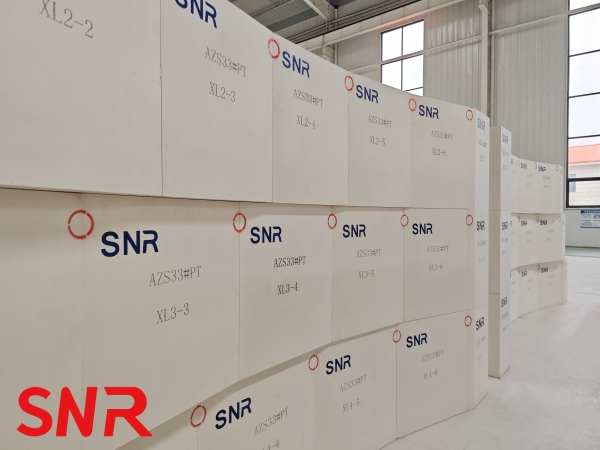
The refractory materials in parts such as the main arch, chest wall, and the upper part of the regenerator of the furnace need to withstand certain pressure fluctuations. High-quality silica large arch bricks and fused cast AZS blocks used in key parts, due to their excellent high-temperature structural strength and creep resistance, are crucial for maintaining the stability of furnace pressure and the structural integrity of the furnace body. They can effectively resist the stress caused by slight positive pressure or pressure fluctuations, prevent cracking or deformation, and ensure the safe and stable operation of the furnace.
Conclusion
The green, environmentally friendly, healthy, innovative, and high-quality development of glass enterprises will be the main theme of social development. Only by effectively strengthening the management of each process link from raw materials, melting, to forming, and truly improving the melting quality in glass production, can the product quality and grade be enhanced, and the enterprise brand be continuously improved. During this process, the furnace, as the core equipment, its inner lining refractory materials, especially the high-performance fused cast AZS blocks selected in key high-temperature areas (melting end, throat, feeding area, hot spot), are the material basis for ensuring the stable implementation of the melting process and achieving high-quality melting. The excellent corrosion resistance, high-temperature stability, thermal shock stability, and low pollution of fused cast AZS blocks directly determine the service life, energy consumption level, melting efficiency of the furnace, as well as the purity and uniformity of the final glass liquid. Therefore, scientifically selecting the appropriate grade of fused cast AZS blocks, ensuring their high-quality masonry and precise hot repair and maintenance, and closely integrating their performance advantages with optimized process control (such as stable temperature systems, bubble boundaries, furnace pressure, liquid levels and atmosphere) are the keys for end fired furnaces to achieve precise control of melting quality, enhance product grades and competitiveness.

Henan SNR Refractory Co., Ltd (SNR) produces a variety of high-quality fused cast AZS blocks.If you have any needs, please contact me.
Web:www.snrefractory.com